Story published December 2016
Screenshot from the AVMA.org 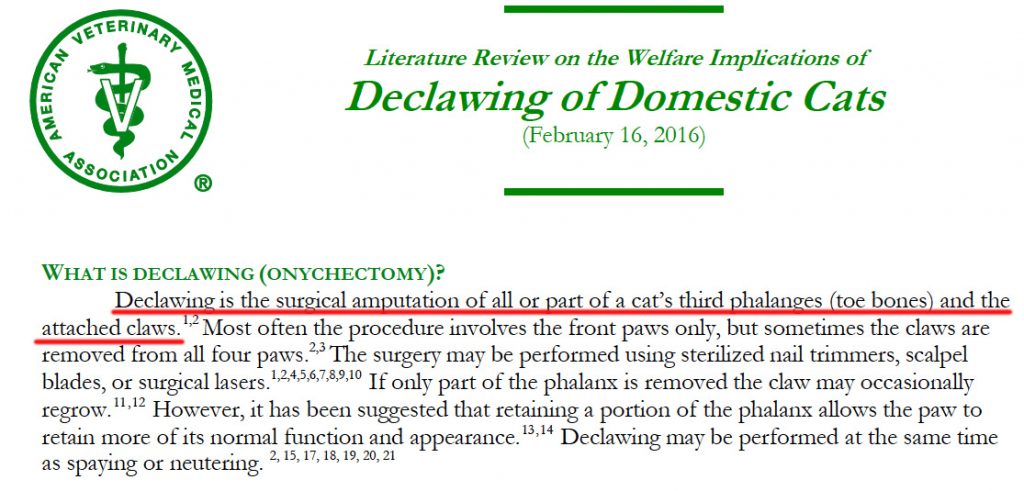
Here is a diagram from AVMA.org Client Handout on Declawing. 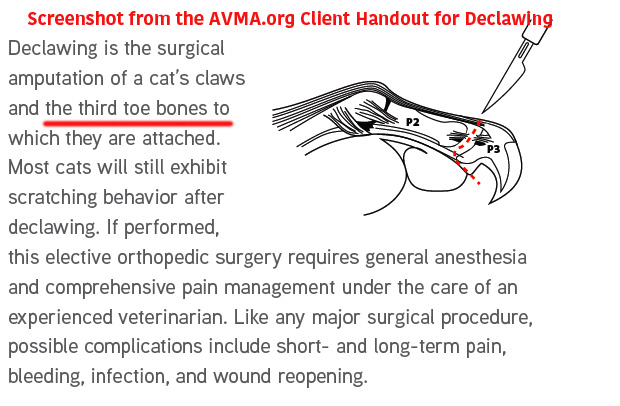
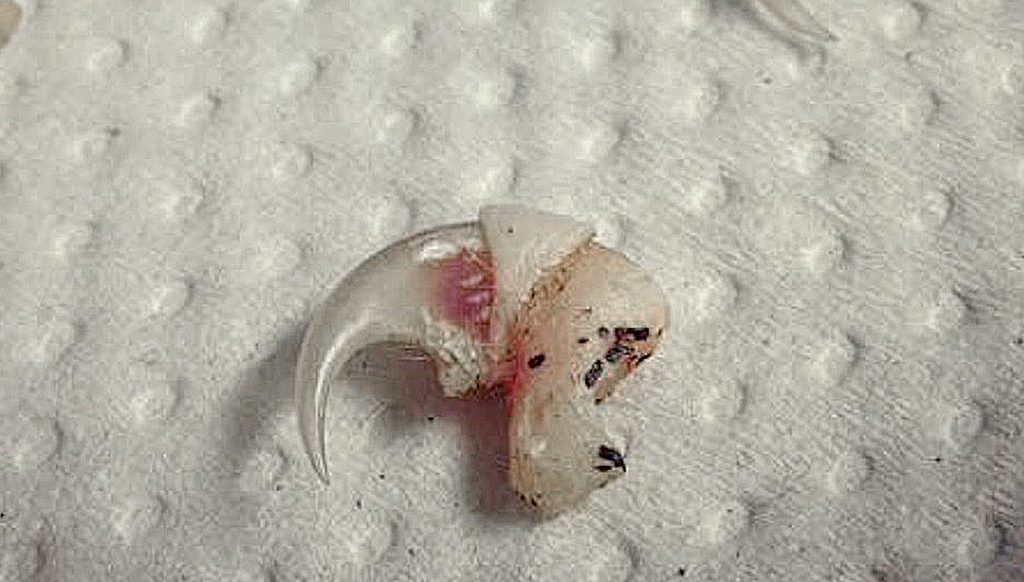 This is a photo of a declawed cat toe bone and claw.
This is a photo of a declawed cat toe bone and claw.
Dr Mike Yurkus with the NJVMA, said this to legislators during his testimony to the NJ Assembly Committee Hearing on November 14, 2016 (2.30 minute mark in this audio) “It is incorrect that the last bone of the finger is removed. It is the nail bed. The claw bed is removed and the tendons are detached. Bone is not removed. We do not cut bone.”
(We reached out to Dr Yurkus for this story but he never returned the email with the answers to my questions that are posted at the end of this story.)
Here is the 7 minute audio of his testimony to the legislators.
If they don’t tell the truth about declawing to legislators in a New Jersey House Committee Hearing, then how can anyone believe what they say to their clients, or to the news media, or to the public?
1) Dr Mike Yurkus said,(2.25 min mark) “It is incorrect that the last bone of the finger is removed. It is the nail bed. The claw bed is removed and the tendons are detached. Bone is not removed. We do not cut bone.”
FACT- Declawing is always the amputation of the last bone that the cat’s claw is attached to. Many of the New Jersey veterinarians, including one of the NJVMA board members practice Oradell Animal Hospital, in my study, use the old school clipper method, which often cuts just part of the bone off and the cats are left with painful bone chips in their paws.
In fact, here are some of the comments from my study from practices in NJ about how declawing is performed. [button href=”https://citythekitty.org/studynjvetsdeclawing/” newwindow=”yes”] NJ vet practices declawing study[/button]
VCA Maple Shade Animal Hospital- They say they use a scalpel to “separate the bone.”
Evesham Veterinary Clinic- They say , “it’s simple and they go in and remove the nail and some of the bone.”
Stafford Veterinary Hospital –They say, “declawing IS an amputation of each toe.
“Maywood Veterinary Clinic- declawing is like cutting off your fingers at the first knuckle and is traumatic and some cats will bite more”
Lawrence Animal Hospital- They said that they don’t declaw and never did it because “it isn’t good” and is “taking the bone on the cats paw.”
This is a photo of declawed toe bones that were chopped off with clippers and you can see that many of them have been cut THROUGH the bone. Photo was posted on Instagram by a veterinary professional.
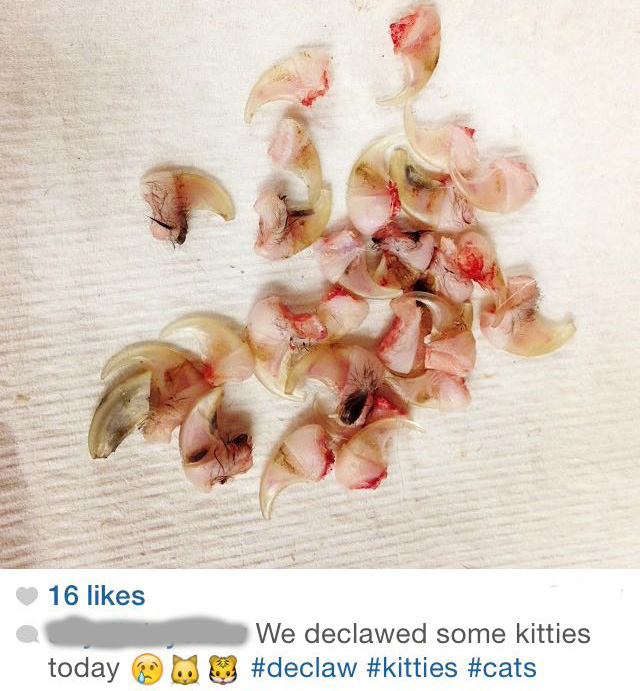
These are a cats toe bones that have been sliced off by a scalpel at an AAHA hospital.

These are a cats toe bones that were burned off by a laser. You can see the burn marks on them.
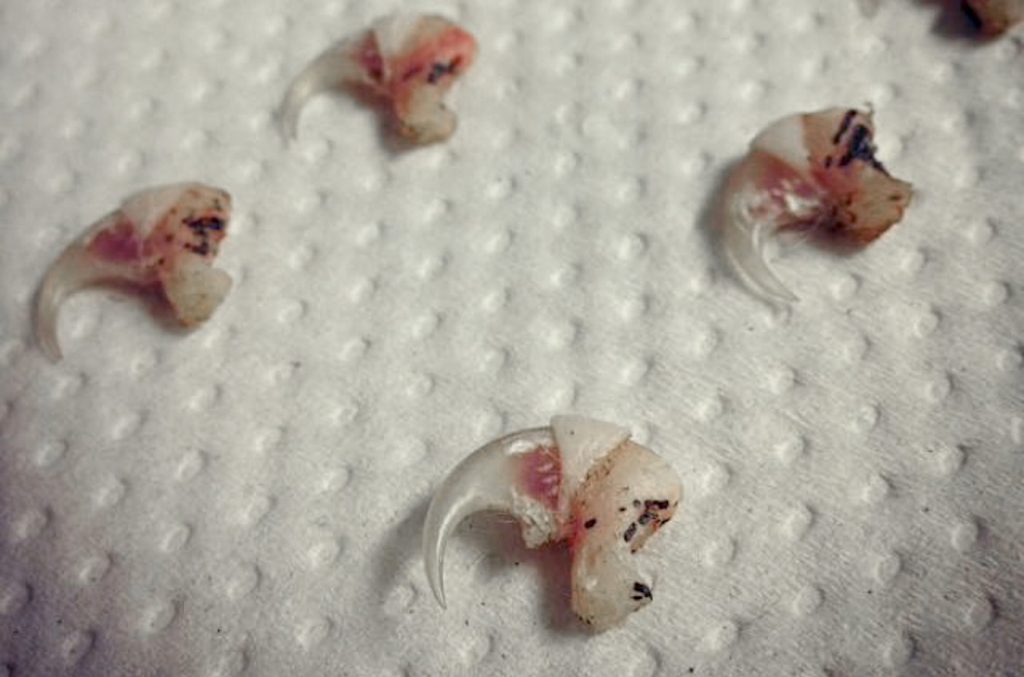
2) Dr Yurkus said, ” there are no studies that associate declawing with any long term behavioral problems.”
FACT- There are many studies in the screenshot below that associate declawing with long term behavioral problems such as litter box avoidance and biting. Here are 11 studies from Dr Jean Hofve, DVM, that clearly show there are long term behavioral problems.
- “Results of the study reported here supported the hypothesis that onychectomy is associated with an increase in house soiling behavior of cats.” Gerard AF, Larson M, Baldwin CJ. Telephone survey to investigate relationships between onychectomy or onychectomy technique and house soiling in cats. Journal of the American Veterinary Medical Association. 2016 Sept 15; 249(6): 638-642.
- “Feline onychectomy is also associated with adverse social behavior, such as inappropriate urination and biting in some cats.” Ellison GW. Feline onychectomy complications: prevention & management. NAVC Clinician’s Brief. 2003 April:29-33.
- “[A] common concern is behavioral changes, which may include decreased activity, decreased appetite, or increased aggression. (Gaynor J. Chronic pain syndrome feline of onychectomy. NAVC Clinicians’ Brief. 2005 April.)
- [Out of 39 cats] “six cats that underwent onychectomy would not use the litterbox (house soiling)… and 7 cats had an increase in biting habits or intensity of biting following onychectomy.” That is, 33% of cats developed behavior problems (house soiling or biting) after being declawed. (Yeon SC, Flanders JA, Scarlett JM, et al. Attitudes of owners regarding tendonectomy and onychectomy in cats. Journal of the American Veterinary Medical Association. 2001;218:43-47.)
- A review of the veterinary literature on declawing found evidence of behavior problems after surgery. Declawed cats were almost as likely to bite as unneutered cats. (Patronek GJ. Assessment of claims of short- and long-term complications associated with onychectomy in cats. Journal of the American Veterinary Medical Association. 2001 Oct 1;219(7):932-937.)
- “Short-term complications included… changes in behavior, such as inappropriate urination….” (Jankowski AJ, Brown DC, Duval J, et al. Comparison of effects of elective tenectomy or onychectomy in cats. Journal of the American Veterinary Medical Association. 1998;213:370-373.)
- “Among relinquished cats, 25 of 84 (29.8%) declawed cats had daily or weekly inappropriate elimination… and 16 (19%) of declawed cats were aggressive toward people on a daily or weekly basis… After adjustment for other variables, being declawed… [were] associated with an increased risk for relinquishment.”). Inappropriate elimination was far more common in declawed (52.4%) as intact cats (29.1%); and declawed cats were nearly twice as likely to be relinquished. (Biting was reported for approximately 12% of declawed cats… housesoiling was reported for approximately 25% of declased cats versus approximately 15% of sexually intact cats…, GJ, Glickman LT, Beck AM, et al. Risk factors for relinquishment of cats to an animal shelter. Journal of the American Veterinary Medical Association. 1996;209:582–588.)
- “Three behavioral changes (house-soiling, no longer covering stools, and disliking paws being handled) developed after declawing… 4% reported a possible increase in biting or harder biting following declawing.” (Landsberg GM. Cat owners’ attitudes toward declawing. Anthrozoos 1991;4:192-197.)
- An internet survey found that declawed cats were more likely to jump on tables and counters, and also house-soiled more than non-declawed cats (25% vs. 15%). (Morgan M, Houpt KA. Feline behavior problems: the influence of declawing. Anthrozoos. 1989;3:50-53.)
- “After declawing, one cat (4%) began to defecate outside the litter pan and three (12%) began to bite,,, 54% of the cats with behavior problems were declawed.” More than half of cats with reported behavior problems were declawed, yet only 25-30% of all cats are declawed. (Bennett M, Houpt KA, Erb HN. Effects of declawing on feline behavior. Companion Animal Practice.1988;2:7-12.)
3) Dr Yurkus said, “A review of declaw studies, and I brought three, it shows that long term lameness is observed in less than 1% of declawed cats.” (3.30 min mark)
FACT- The study he is most likely referring to is this one. Dr Yurkus left out the additional information on long term lameness in cats in this study, “A review of onychectomy studies reported that persistent lameness was observed in less than one percent of declawed cats (five of 582, or 0.86%).28 However this rate varies according to the population being observed, for example one study comparing onychectomy methods classified 12 of 88 (13.6%) of cats as mildly lame at the long-term recheck.49 The short-term and possibly long-term pain that can result from onychectomy could be related to neuropathic pain, residual inflammation, infection, or remaining bone fragments. (Robertson S, Lascelles D. Long-term pain in cats: How much do we know about this important welfare issue? J of Fel Med and Surg 2010; 12: 188-199.)
Link to this info is on the AVMA.org site on this pdf- [button href=”https://webcache.googleusercontent.com/search?q=cache:KYYmcI9icvIJ:https://www.avma.org/KB/Resources/LiteratureReviews/Documents/declawing_bgnd.pdf+&cd=15&hl=en&ct=clnk&gl=us” color=”red” newwindow=”yes”] AVMA Declawing Info and Studies[/button]
Here is another 2014 Canadian Study that the NJVMA doesn’t want you to see.[button href=”https://www.ncbi.nlm.nih.gov/pmc/articles/PMC3923482/” color=”red” newwindow=”yes”] 2014 Canadian Veterinary Journal Declawing Study [/button]

Also, below are examples of studies that found that 20% of cats had long term lameness (1994 study) and a 2005 study that described cats suffering from a chronic pain syndrome as a result of declawing.
4) Dr Yurkus said, “The discomfort level is no more than in a neuter than it is in the declaws that are done properly.”
Here is how the NJVMA rated declawing in 2007 in their NJVMA Animal Welfare Task Force. Guidelines for Preventing, Recognizing, and Treating Pain in the Hospital Setting.
“Moderately Severe to Severe:” onychectomy. It was in the same category as cancer pain, fracture repair, limb amputation and many other painful procedures.
Here’s how they rated neutering, “Mild to Moderate: ovariohysterectomy (OVH) (young animals), castration.”
FACT- DVM Best Practices, August 2002, veterinarian Kip Lemke illustrates typical levels of post-surgical pain using common surgical procedures. Declawing is associated with “severe pain,” compared against spaying (“moderate pain”) and neutering (“mild pain”).
Pollari states in JAVMA (June 1, 1996), “Because these procedures are so routine, they are often trivialized by clients as well as veterinarians.”
“Declawing is very painful – there’s no question about that…” says Dr. Katherine Houpt, Professor and Director of the Animal Behavior Clinic at Cornell University’s College of Veterinary Medicine. Information from PawProject.org
And if it’s not that painful then why are they saying that they use all the pain management protocols and nerve blocks.
Also, Dr Marty Becker wrote a story about how painful declawing is, with a leading pain specialist, Dr Robin Downing, who said, “Unfortunately, as the latest survey conducted by DVM360 revealed, a huge percent of cats do not receive appropriate post-operative pain management.”
5) Dr Yurkus said, “We recently conducted a study in New Jersey of our members and over 100 practices got back to us. The average number of declaws that is done by the average practice in New Jersey is less than 9 a year.” “My own practice, we are a large practice, we have only done two this year.” (4 min mark)
FACT- We conducted a study involved 110 New Jersey veterinary practices in Nov., 2016. Our study revealed that of the practices that declaw cats, 72% performed multiple declaws each month, which would average a minimum of 24 a year. This 72% or 70 practices (out of 97) stated they perform declaws “routinely”, “commonly”, or “frequently”. Some vets even said they do several per week, which would add up to over 100 per year. At least one vet said declawing is “as common as spays and neuters” at their practice.
A vet tech from Dr Yurkus’ practice told an investigator in our study, “it’s a regular surgery and it’s done commonly here,” in regards to how many declaws they do.
Also, Dr Yurkus’ own practice said they’ve done 4 declaws in the last 4 months in this comment on facebook.
6) Dr Yurkus said there is nothing that supports the fact that declawed cats are relinquished to shelters because of inappropriate behavior issues such as litter box avoidance issues.
FACT- There are studies that support the fact that declawed cats are relinquished to shelters because of inappropriate behavior issues such as litter box avoidance (declawed cats avoid the litter boxes because their paws are in pain. That’s why vets recommend Purina’s Yesterday’s News cat litter for their client’s cats after the declaws because it is made from recycled newspaper and is “gentle on sensitive paws) and also facts from a NJ shelter that says 80% of declawed cats that are surrendered are euthanized because of behavioral issues.
7) Dr Yurkus said, “We use nerve blocks” and he talks about all the pain management methods used by vets for declawing. (3 min mark)
FACT- Not all veterinarians use nerve blocks when they declaw cats. Example is in my study from a NJVMA board members practice, Burl-Moor-Driben Animal Hospital. Employee at the hospital said, “If you have Dr Souders do it they would be fine and she does them quite frequently and she uses the nerve blockers so it’s not as painful. Especially because the older the cat the more painful it is for them.“ “The one that uses the nerve block is the one that I would recommend. They don’t all use the nerve blocks.” Number 3 practice in my study [button href=”https://citythekitty.org/studynjvetsdeclawing/” color=”red” newwindow=”yes”] NJ vet practice declawing study[/button]
Also, Dr Marty Becker wrote a story about how painful declawing is, with a leading pain specialist, Dr Robin Downing, who said, “Unfortunately, as the latest survey conducted by DVM360 revealed, a huge percent of cats do not receive appropriate post-operative pain management.” [button href=”http://www.drmartybecker.com/veterinary-medicine/the-tragedy-of-post-declaw-pain-syndrome-and-how-to-help-cats-who-suffer-from-it/” color=”red” newwindow=”yes”] Dr Marty Becker story about declawing[/button]
Also there are many practices that use minimal pain meds and make it optional to get the take home pain meds for declawed cats. [button href=”https://citythekitty.org/declawed-without-pain-meds/” color=”red” newwindow=”yes”] Declawed with NO Pain Meds[/button]
Here is another example of a vet practice that makes the pain meds optional for declawing [button href=”https://citythekitty.org/medieval-torture-the-american-declaw-procedure/” color=”red” newwindow=”yes”] Pain Meds Optional for Declawing[/button]
8) Dr Yurkus said, “We are only doing this as a last alternative” and say that declawing is only offered as a last resort after all other methods and education have failed.
FACT: Our investigation revealed that only 12% of NJ practices who declaw cats offered or suggested alternatives or asked why the cat owner wanted to declaw his or her cat. To the contrary, most of the vets promoted how good their doctors were at declawing, how many they have done, or how good their technique or tool works for declaws.
9) Dr Yurkus said this in regards to the declawing method that their vets use, “In this day and age it is either usually a laser or scalpel disarticulation.” (2.27 min mark)
FACT- Many veterinarians in America still declaw cats with the old school method, the clippers. In my study of 110 vets, in the ones who said the method they use, 15 used laser, 15 use scalpel, 1 uses Electro-surgical, and 14 use the old school clipper method. [button href=”https://citythekitty.org/studynjvetsdeclawing/” color=”red” newwindow=”yes”] Declawing Study with NJ practices[/button]
HERE ARE SOME STUDIES THAT THE NJVMA DOESN’T WANT THE NJ LEGISLATORS TO SEE


We reached out to Middletown Animal Hospital, Dr Yurkus’ practice, on Dec. 16 to get his email and sent him the email listed below. We told him that my deadline was Dec. 19th at 4pm EST and spoke with him briefly on that day and told him about this story and sent him an email. He said, “I will see what I can do. Have a good one.”
We called Middletown Animal Hospital today Dec, 19th and spoke with a woman on the phone and said that I was calling to check to see if Dr Yurkus wanted to answer the important questions. She said, “I know that he received the email and I think he said that he wasn’t going to be answering any of those.” She said that he knew what my deadline was and that if he was going to be answering my questions he would have done it by now. Before I could get her name, she hung up.
Here is the email that I sent to Dr Yurkus.
Here are the questions we sent to Dr Yurkus:
1) You said in regard to cat declawing, “It is incorrect that the last bone of the finger is removed. It is the nail bed. The claw bed is removed and the tendons are detached. Bone is not removed. We do not cut bone.”
Do you still believe this to be the case, and if so, what do you say to veterinary surgery textbooks that say in order to remove the claw forming tissue and the claw, you must remove the bone?
2) You said, “There are no studies that associate declawing with any long term behavioral problems.”
A brief internet search yields multiple studies that show long term behavioral changes. What was your reason for disallowing these studies in your testimony? Attached are just a few of those studies.
3) You said, “long term lameness is observed in less than 1% of declawed cats.”
Again, a brief internet search has that number at 20% in peer reviewed journals. What was your reason for ignoring that number and going with 1%? What is the citation for the 1%? Attached are some studies that show the percentage is a lot higher than 1%.
4) You said, “The discomfort level is no more than in a neuter than it is in the declaws that are done properly.”
Were you aware that many vet textbooks list declawing as severe pain and declawing is used for pain clinical trials because it is so predictably painful? What was your reason for saying that declawing was no more painful than a neuter, which is listed in those same textbooks as mild pain?
5) You said, “We recently conducted a study in New Jersey of our members and over 100 practices got back to us. The average number of declaws that is done by the average practice in New Jersey is less than 9 a year.” “My own practice, we are a large practice, we have only done two this year.”
We conducted a study involved 110 New Jersey veterinary practices in November, 2016. My study revealed that of the practices that declaw cats, 72% performed multiple declaws each month, which would average a minimum of 24 a year. This 72% or 70 practices (out of 97) stated they perform declaws “routinely”, “commonly”, or “frequently”. Some vets even said they do several per week, which would add up to over 100 per year. At least one vet said declawing is “as common as spays and neuters” at their practice. A vet tech from your own practice told an investigator in our study, “it’s a regular surgery and it’s done commonly here.” Also, your own practice said that your practice has done 4 declaws in the last 4 months in two comments on facebook posts. It’s obvious that the vet practices in NJ that do many declaws chose to not get back with you for your study. How do you explain the results of my study vs. yours?
6) You said there is nothing that supports the fact that declawed cats are relinquished to shelters because of inappropriate behavior issues such as litter box avoidance issues.
Attached are studies that support the opposite. How do you explain the studies that contradict your comments?
7) You said, “We use nerve blocks” and talk about how the pain management for declawing has improved.
Not all veterinarians use nerve blocks. An example is from one of your fellow board member’s practice, Burl-Moor-Driden. They said that only one of their vets use nerve blocks. They recommended Dr Souders because she is the only one that does. How do you explain your statement?
8) You said, “We are only doing this as a last alternative” and say that declawing is only offered as a last resort after all other methods and education have failed.
My investigation revealed that only 12% of NJ practices who declaw cats offered or suggested alternatives or asked why the cat owner wanted to declaw his or her cat. To the contrary, most of the vets promoted how good their doctors were at declawing, how many they have done, or how good their technique or tool works for declaws..
How do you explain this discrepancy?
9) You said this in regards to the declawing method that NJ vets use, “In this day and age it is either usually a laser or scalpel disarticulation.”
The facts are that many veterinarians in America still declaw cats with the Resco method. In my study of 110 NJ vets, in the ones who disclosed the method of declawing that they use, 15 use laser, 15 use scalpel, 1 uses Electro-surgical, and 14 use the clipper method.
Were you not aware that around 1/3 of vets in NJ and in America still use the Resco clipper for declawing?
10) Were you paid or coached for your testimony? If so, by whom?
Please get back with me on your answers to these very important question by my deadline, Monday Dec., 19, 2016 4:00 PM Eastern time, so that I can put them in my story.
Here are more facts about declawing from PawProject.org and the Humane Society Veterinary Medical Association for the New Jersey bill.
Bill A3899 (Singleton)/S2410 (Vitale, Lesniak)
Fact Sheet
- Overview of A3899/S2410
- Prohibits the declawing or flexor tendonectomy of cats or other animals in New Jersey unless medically necessary (therapeutic purpose).
- Therapeutic purpose is defined as “the necessity to address the medical condition of the animal, such as an existing or recurring illness, infection, disease, injury or abnormal condition in the claw that compromises the animal’s health.”
- What is Onychectomy (declawing)?
- Declawing involves multiple amputations – of the last bone of each of the cat’s digits – it is surgery and NOT simply removing the cat’s nails.
- The American Animal Hospital Association (AAHA) states that it “strongly opposes the declawing of domestic cats,” noting that it is “major surgery involving amputation.”
- Declawing can make a cat more likely to bite or less likely to use the litter box (due to short or long-term pain in the paws)
- Other methods to prevent unwanted scratching:
- Keep claws trimmed
- Provide scratching posts
- Ask a veterinarian about proper training and/or soft plastic caps (Soft Paws®) that are placed on the cat’s nails
III. Organizations in Support of S.5084/A.1297
National Animal Protection Agencies
- Humane Society of the United States
- Humane Society Veterinary Medical Association
- The Paw Project
- Alley Cat Allies
- Last Chance for Animals
- Veterinarians Want to End Declawing
The Paw Project and the Humane Society Veterinary Medical Association are veterinarian-run organizations that support legislation to end declawing.
“Let’s embrace this new wave of concern over the practice of declawing. Just as our profession once held a belief that animals don’t feel pain, and more recently thought it was acceptable to leave animals in pain if we needed to keep them quiet, let’s put this one into the history books where it belongs!” – Dr. Marty Becker, “America’s Veterinarian” and the author of 22 books that have sold more than 7 million copies combined, including three New York Times best-sellers. The tragedy of post-declaw pain syndrome, and how to help cats who suffer from it. (December 11, 2015).
- Declawing is Currently Banned or Considered Unethical by Veterinary Professional Organizations in Many Areas Across the World
- Australia
- Austria
- Brazil
- Croatia
- Germany
- Ireland
- New Zealand
- Norway
- Sweden
- Switzerland
- United Kingdom
- California cities (Los Angeles, San Francisco, Berkeley, Beverly Hills, Burbank, Santa Monica, Culver City, West Hollywood)
- Cat Health and Well-being
- Declawing does not keep cats in homes. It can lead to biting and avoiding the litter box. These are the top behavior reasons cats are given to shelters. The American Animal Hospital Association (AAHA) states, “Declawing does not guarantee that cats will remain in households.”
- Los Angeles banned declawing in 2009. Every year since, A. Animal Services has seen lower numbers of cats given to its shelters than in the years before the ban.
- San Francisco’s Department of Animal Care and Control has recorded a 22% decrease of cats being placed in shelters following the enactment of their declawing ban.
- Vets aren’t declawing only as a “last resort.” “It is estimated that this procedure is done in 19% to 46% of the U.S. cat population.” (Clinician’s Brief)
- Regardless of the technique used to perform declawing or tendonectomy, post-operative problems may include: pain in the paw, bleeding, infection, tissue death, arthritis, loss of balance and back pain.
- Up to 50% of cats have negative effects right after being declawed. 20% have long-term problems (Washington State Vet Med Association’s Summary of Articles Studying Surgical Declawing of Domestic Cats).
VII. Human Health
Human health authorities agree that declawing is not an effective or reasonable means for protecting human health.
“Declawing is not advised”
Guidelines for the Prevention and Treatment of Opportunistic Infections in HIV-Infected Adults and Adolescents, The National Institutes of Health (NIH), Centers for Disease Control (CDC) and Infectious Diseases Society of America (IDSA) joint position paper
“Exercise caution when playing with cats to limit scratches; keep cats’ nails short (declawing is not recommended).”
Reducing the Risk of pet-associated zoonotic infections, Canadian Medical Association Journal (2015)
“You need not declaw the cat”
The Guide to Living with HIV Infection (5th Edition), Dr. John Bartlett, M.D., professor of medicine in the Division of Infectious Diseases at The Johns Hopkins University School of Medicine and past president of the Infectious Diseases Society of America (IDSA). (2001)
The American Feline Practitioners Association (AAFP) has acknowledged, “Of note, the Centers for Disease Control and Prevention does not advise declawing cats owned by HIV-infected persons…”
VIII Declaw Bans Do Not Lead to Increased Cat Relinquishment
Eight cities in California have declaw bans. Five of the eight have their own Animal Shelter Systems. IN ALL FIVE of those cities which do have shelter systems, cat intake numbers for their shelters have decreased, ranging from 6.5% to 43.3%, when the five years prior to the declaw ban and the five years after the declaw ban are compared.

